I’m making up for LOTS of lost time now that FRANK is on hiatus, as I haven’t blogged regularly since early summer! Things have been hectic, tons of travel, loads of cooking, and not nearly enough sleep… Most photos in this post appear courtesy of the amazing Stephanie Casey, who has a really cool blog Real Fine Food and has been fundamental in helping blitz photos of our dinners out in real-time to our fans around the globe.
For the July 4th holiday, we decided to celebrate our American food traditions at FRANK by doing a menu inspired by some classic favorites from around our country. Most folks think of America as being a culinary desert, with no real food identity to call our own, and that all our fundamental classics were borrowed from other cultures. (A statement that is actually true of MOST other cultures! The Italians borrowed their iconic pasta from the Chinese.)
But America, and in particular the South, has a very strong history of original classic dishes, and both Jennie and I grew up in stoutly Southern households, so we were ready to revisit some favorites from our childhood and improve upon some seminal dishes we never really cared for, and churn out a mouth-watering menu worthy of Independence Day. Here’s what we came up with:
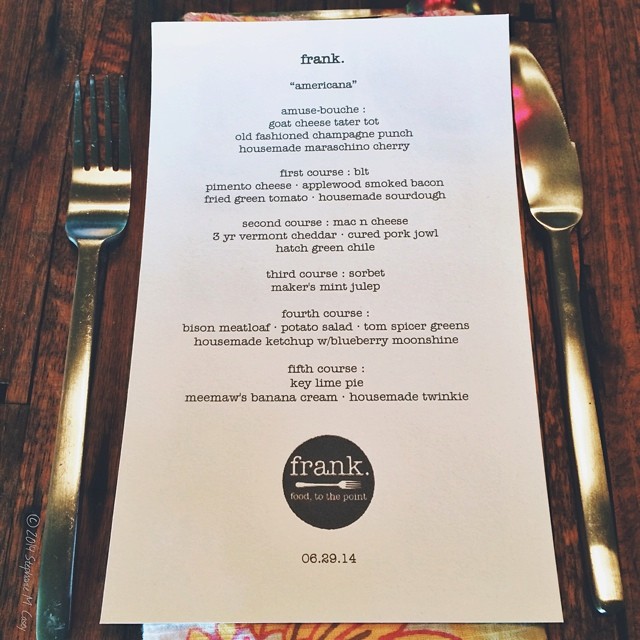
For the welcome bite, or amuse bouche, we settled on that most decidedly American invention: the humble tater tot. Who among us didn’t ingest literal TONS of tater tots in school cafeterias as a kid? The tater tot was invented in 1953 by Mormon brothers Nephi and Golden Grigg, who owned the Ore-Ida potato company. (That’s a shortened version of Oregon/Idaho Potato Growers.) They had an abundance of leftover potato scraps after turning whole potatoes into french fries, and they didn’t want to just toss them out. The ended up mixing them with binders (flour, egg, and spices) and extruded them into long tubes which were cut into little round barrel shapes and deep fried. They placed them in the frozen section of grocery stores at a really cheap price, and nobody bought them, because they thought, “Why would I spend even less on the cheapest thing anyone could ever buy…potatoes?” Just before scrapping the entire idea, the Grigg brothers put their heads together and decided to raise the price higher than french fries, and suddenly everyone wanted the BETTER version of the french fry. One of their employee’s wives actually christened the name “tater tot” and it became an iconic American institution.
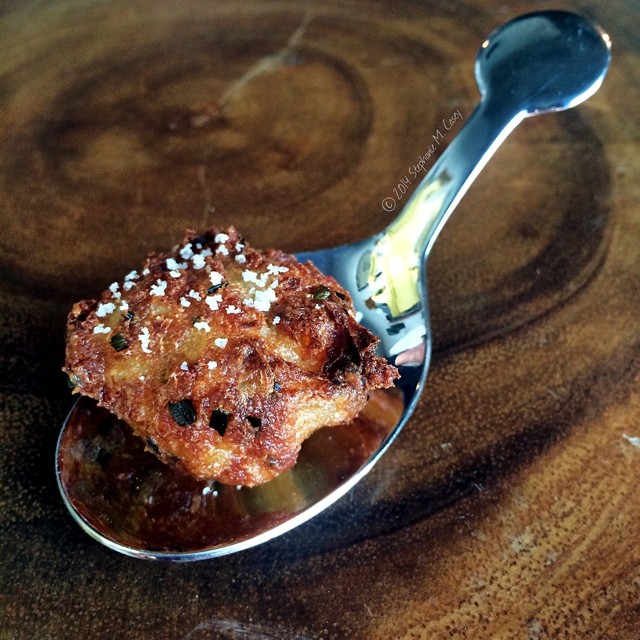
We both LOVE tater tots. Even alone, with no toppings, they are amazing. So we decided to do a FRANK spin on a tater tot, combining some local goat cheese and chives with the potato, and deep frying it to a crisp crust. When we do our end-of-meal survey, it’s fairly rare for the amuse bouche to garner more than a vote or two each night, because so many larger plates of yummy things have been paraded past our guests that they scarcely remember the little bite they had when they walked in the door. But our tater tot got LOTS of votes for best dish of the night. If they weren’t so labor intensive, I could imagine a main course of these goat cheese tater tots, topped with a poached egg, caramelized onions, bacon… *drool*
We paired this with a welcome cocktail, a hybrid between and Old Fashioned and a champagne punch, complete with a housemade maraschino cherry. Modern maraschinos are typically Rainier cherries that are first bleached to remove their color, then dyed red and sweetened. I’m not sure why ANY cherry needs to be sweetened, it’s sweet enough as it is! Our cherries were simply pitted and warmed gently in bourbon and bitters, then left to macerate for a week.
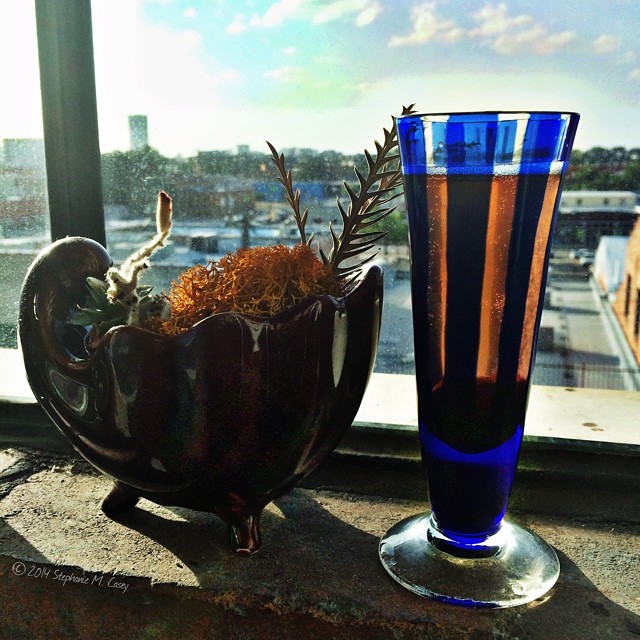
For the opening course, it was a slam dunk. This may be my favorite thing we have EVER served at FRANK, and it was a sandwich.
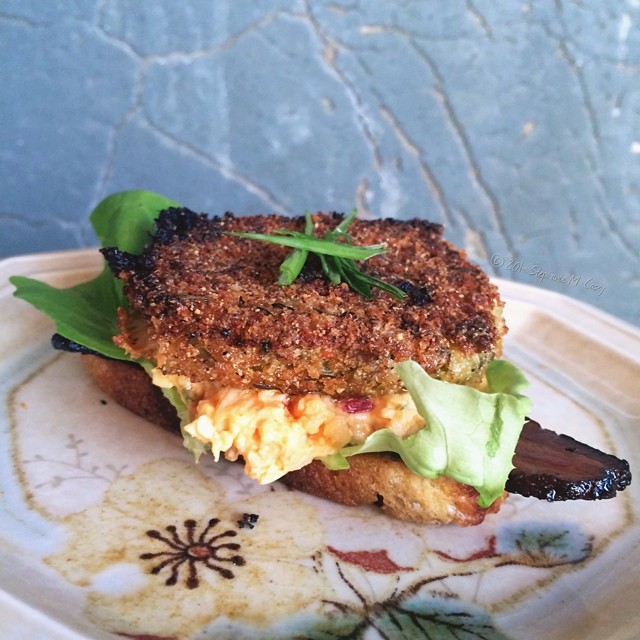
That’s right. A sandwich. Typically when you dine at a fairly pricey, fixed-course restaurant, you don’t expect a sandwich. And we rarely serve them at FRANK. But when we do, they are epic. And this one was no less than epic. It started with a slice of our housemade sourdough bread, griddled in butter and bacon fat until crisp. Atop that was a leaf of butter lettuce cradling pimento cheese. If you’ve never had pimento cheese, it’s tough to describe it in an alluring way. If you’ve had it, you either love it or hate it. Traditionally, pimento cheese is just grated cheese mixed with mayonnaise and pimentos (roasted red peppers). Sounds gross…and to be honest, it is. Neither Jennie nor I like traditional pimento cheese. But there’s SO much potential there for something truly stellar. So we took 5-year aged Oregon cheddar (incredibly sharp) and folded it gently with sour cream (so much better than mayo), thinly sliced shallot, chives, pimentos, and probably a gallon of Crystal’s hot sauce, and it was a revelation. Spicy, explosively flavored, rich, and decadent. But we didn’t stop there. Then we added a slice of thick-cut, applewood smoked bacon, and then a fried green tomato…another Southern classic. The sandwich was served open faced, and most of our diners simply resorted to picking it up and eating it, rather than knifing and forking it, which was perfectly fine by us. It was like the most epic BLT in human history, hybridized with a spicy grilled cheese. Thank GOD this sandwich is so complicated to make, because if it was easy, I’d weigh about a thousand pounds right now. I’m drooling just typing about it.
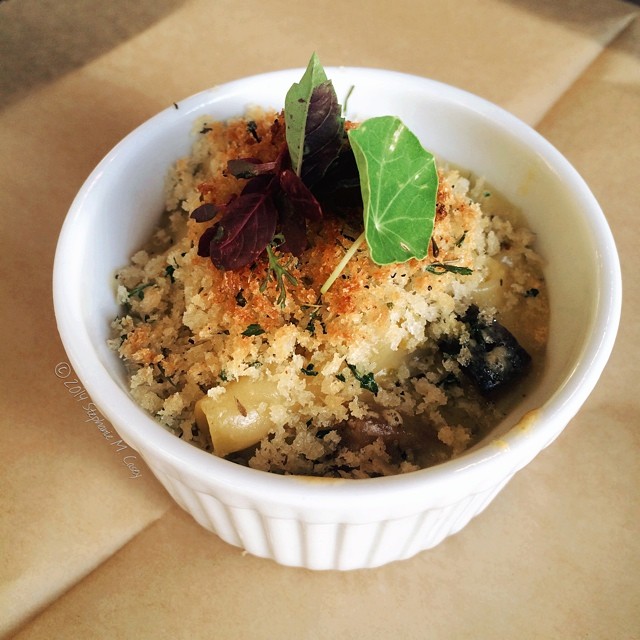
What’s more of a quintessential American dish than macaroni and cheese, huh? The elbow macaroni shape was “discovered” by Thomas Jefferson during a trip to France and Italy, and he brought it back to the US. A chef of his served a cheesy macaroni “pie” at a White House state dinner in 1802, and thus mac and cheese became an American institution. We knew we had to put a mac ‘n’ cheese on the Americana menu, because it’s easily one of our personal favorites…but Jennie and I have each had trouble finding a mac and cheese in Dallas that we truly love. So we decided FRANK would have to introduce one. We went with the elbow shape out of respect to tradition, though I think we both prefer other shapes for the penultimate mac and cheese. Our sauce was made of a combination of cheese, mostly young cheddars and Monterey Jack, with some very sharp, 3-year aged cheddar from Vermont thrown in for punch. Then we folded in Hatch green chiles…an omnipresent seasonal ingredient in the Southwest during summer and early fall. And, of course, some crispy, smoked pork jowl…because everything is better with pig in it.
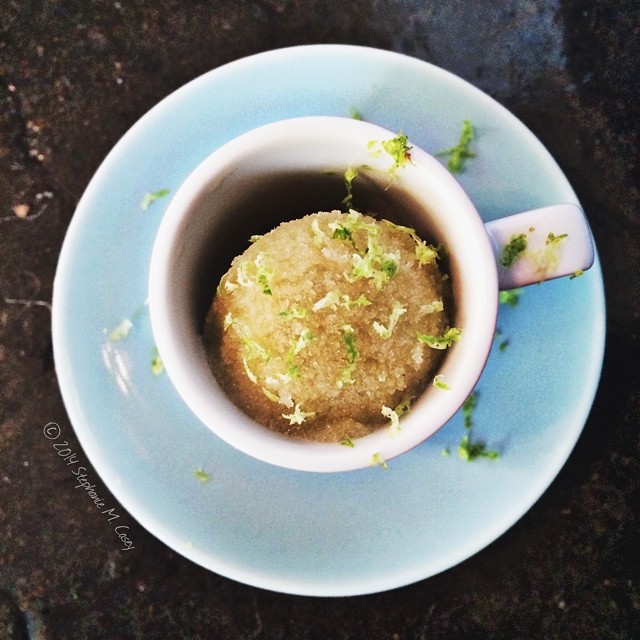
Two very rich courses have gone by, and we needed to give our diner’s palates a break before the main attraction, so it was time for a sorbet. We’ve been doing “boozy” sorbets at FRANK of late, and our diners love them. There are tons of classic American cocktails, but the first one that came to our minds was the mint julep. No one is certain who invented this combination of bourbon, mint, and lemon…but its reputation reigns supreme in the South, where it has become the official cocktail of the Kentucky Derby. We made ours with reduced Maker’s Mark, fresh mint and lemon, frozen until frosty, served with a grating of lime zest. Very refreshing and crisp…just the thing to reset the palate for the main course.

Choosing the main wasn’t easy. At all. How many classic American dishes are there? Fried chicken? Pot roast? Pork chops? Roast chicken? Hamburger? Chili? Sloppy Joe? Chicken pot pie? Barbecue? Beef stew? Any of a dozen casseroles? We kept coming back to meatloaf. Not because we love meatloaf. Personally, I hate meatloaf. Jennie isn’t that fond of it either. The sallow, under-seasoned church potluck meatloaves we grew up with were wretched, filled with undercooked, oversized chunks of green bell pepper and smothered in ultra-sweet Heinz 57 ketchup…I literally gag thinking about it. But what IS meatloaf? It’s a giant sausage. And sausage is mankind’s most delicious invention. So there was a LOT of untapped potential there, and we were determined to create a meatloaf that would utterly blow people’s mind. We both decided that bison was the best choice to start. Meaty, flavorful, and absolutely American. But bison is incredibly lean, so we supplemented it with pork to keep it juicy and tender. Tons of aromatic veggies and spices to pack in the flavor. Seared on both sides for plenty of crust. And then a housemade ketchup with a base of blueberry moonshine (another American classic) to top it all off. And you can’t serve meatloaf with potato salad. While the Germans may have invented potato salad, we definitely perfected it in the US, and ours was chock full of crunchy veggies, including green beans, which our diners found to be unexpectedly delicious.
If we thought it was gonna be hard picking the main course, it was even harder settling on dessert. Apple pie? Pecan pie? Pumpkin pie? Peach cobbler? Cherry cobbler? Tapioca pudding? Cheesecake? Chocolate chip cookies? Moon pie? Carrot cake? Doughnut? Brownie? We couldn’t decide, so we actually picked TWO desserts, both very American: Key Lime Pie, and the iconic Twinkie. Key Lime Pie was invented in the Florida keys in the early 1900s, when the Keys were still similar to the Wild West…undeveloped, rugged, and frontier. Because there was no electricity, the only dairy they could effectively use (unless they had their own goats) was canned milk. The quick combination of canned milk and juice from their easily available Key limes produced a luscious pie that has become an American favorite.
The Twinkie was invented in 1930 by a baker at the Continental Bakery, just south of present-day O’Hare airport in Chicago. Originally it was filled with banana cream, but during World War II, there was a banana shortage, so they switched to vanilla cream, and later, vanilla “creme.” Whatever that is. Nevertheless, the Twinkie became as iconic an American pastry as the donut, and the rest was history until 2012, when the Twinkie REALLY became history with the bankruptcy of Hostess. “Luckily,” the recipe and brand was licensed by two private equity firms, and the snack cakes are back in the grocery store. (Incidentally, there are many urban legends about the Twinkie’s astronomical shelf life. This is nothing more than a legend. For decades, the shelf life was officially 26 days, but with the new manufacturer, it is now officially 45 days.)
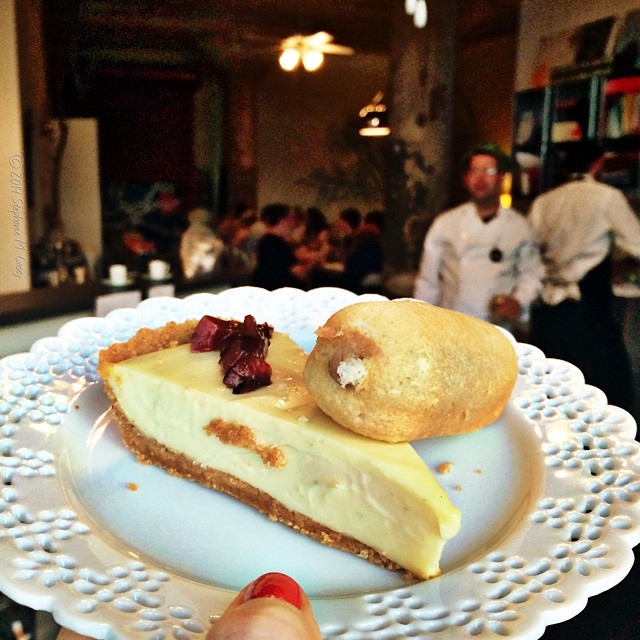 Making Twinkies is no walk-in-the-park. We tested many sponge cake recipes before we found one that wouldn’t shrink up after baking, and would allow us to easily pipe in our fresh banana cream…made using my Meemaw’s banana cream pie recipe. The dessert was a big hit, and started a trend of plating two separate desserts at FRANK which has sporadically continued since.
Making Twinkies is no walk-in-the-park. We tested many sponge cake recipes before we found one that wouldn’t shrink up after baking, and would allow us to easily pipe in our fresh banana cream…made using my Meemaw’s banana cream pie recipe. The dessert was a big hit, and started a trend of plating two separate desserts at FRANK which has sporadically continued since.
Overall, I have to say that this was one of my favorite FRANK menus to date. The food was so familiar to me…things I grew up with, but made even more yummy and creative. Feel free to comment below, and subscribe to my blog near the upper right corner of your screen for lots more yumminess!
 They all look amazing! Would you ever consider doing a vegetarian Frank menu some day?
They all look amazing! Would you ever consider doing a vegetarian Frank menu some day?
Leave a Reply
You must be logged in to post a comment.